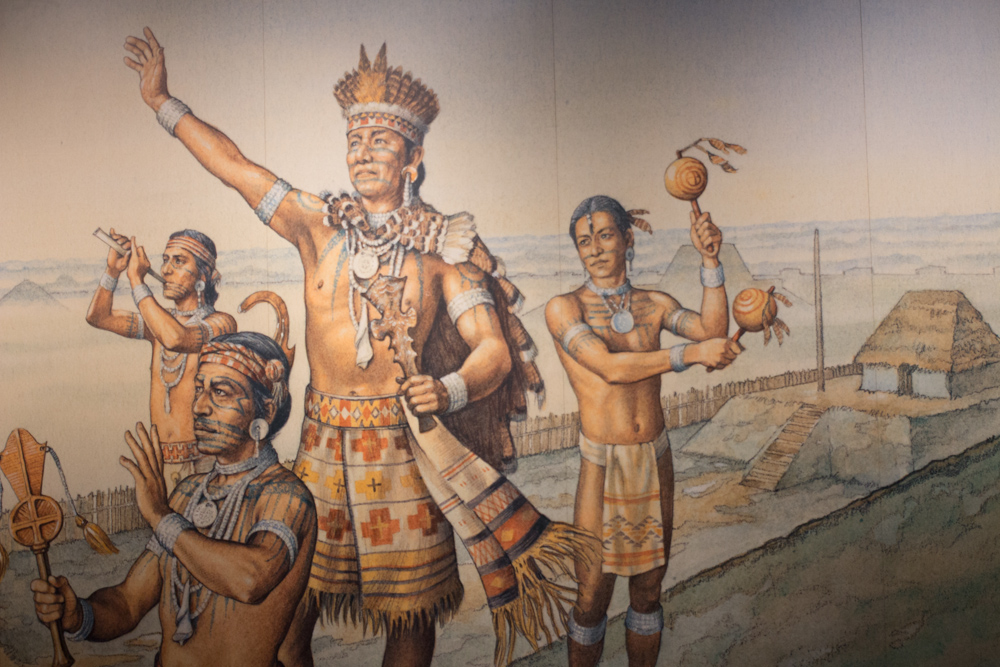Among the Mississippians and their neighbors the art of decorating one’s body with permanent markings of colorful designs was widespread and beautiful to look at.

Or so claimed the later-day French that lived among the Natchez and other nations that considered themselves to be descendants of the great Mound Builders, maintaining a way of life similar to their great ancestors even if of a simpler manner amidst smaller mounds and humbler ceremonies.
People of all walks of life, both young men and women, availed themselves of permanent body markings, usually of simpler designs drawn in red or back – a line crossing the highest part of the nose, or a mark running down the center of the chin, geometric designs that adorned the upper part of the body. The youths were usually allowed to get only most basic facial marks, because more significant tattoos one has to earn by proving one worth with valorous deeds and achievements.
After becoming a warrior with a proven record, a young man was free to help himself to the painful process once again, drawing complicated designs that reflected on his deeds – a likeness of a war club with the hieroglyphic symbol of the nation he had fought against to ornament his shoulder, a figure of a serpent or even a sun on one’s leg or thigh, an effigy of a deity on a chest or a stomach.

All French sources report such designs to be beautiful, completed in black, red or blue lines, to last without fading because of the depth with which the needle was inserting the color into the skin.
The process itself seemed to be simple if painful, resulting as a rule in a few days of fewer and suffering, with the newly tattooed individual put on a strict diet of corn and water nutrition, abstaining from contact with the opposite sex while resting and letting the infected area recover.
Colors of mixed pine charcoal for black, ground cinnabar for red and special sort of grass for blue-greenish hues were used generously, to achieve vivid designs. When those were obtained and ground into a pile of vibrant dust, an artist would be engaged in drawing the desired image with the help of charcoal upon the area that was to be punctured.
Then it was off with the painful process itself.
Five or six needles made of thin sharpened bones of the sort the healers used to stitch wounds with would be attached to a flat piece of wood, each at an equal small interval from each other, fastened at the same depth so no point extended beyond the other. Soaked in relevant coloring, this instrument would be applied to the outlined design, moving quickly over each section of the image, pricking the skin deep enough to draw blood, rubbing additional powdered substance of different hues into each punctured section, pressed into the holes in the skin strongly enough not to fade or efface later on.
As stated above, after such operation, depending on the size of the tattoo, one could be certain of following sickness for at least a few days, with the inflamed punctures drying off slowly, the damaged skin taking its time to recuperate. Still, after the recovery, the desired marking would be there, for everyone to see and behold.
An excerpt from “Shadow on the Sun”, The Mound Builders Series, book #1.
“Will you be getting another marking?” Nara was asking as they made their way toward the Sacred Mound, silhouetted clearly against the glimmering sky. The intensified drumming and soft but most distinct chanting suggested the way as readily. “I would accost the elders for permission to get a real warriors’ marking if I had such a battle with the old forest giant to claim.”
Iciwata grinned to himself, in the best of spirits and feeling better by the moment, the thought occurring to him as well. The real warriors’ tattoo, and why-ever not? “Maybe I’ll get one of those, yes. The last time, it was such a pain, though.”
“What? Why?” demanded several of his followers.
“He was sick like a coyote bitten by a mad wolf.” Hikua, trailing along as always, allowed to be the closest and speak for him on occasions, laughed softly. “Not a dawn or two of feeling bad like always. Worse than that.”
“It wasn’t that bad.” Iciwata rolled his eyes, not as amused by the memory as he tried to pretend. It was bad, those three dawns of sickness, his arm where the pretty red and black marking was inflamed and hurting worse than anything he had experienced before, his mind wandering, body bathed in sweat. A bad memory.
Still, it all would be worth it if he was allowed to make a real warriors’ marking, a tattoo of those who faced an enemy on a battlefield and came out victorious. A few boasted that, unlike in the snooty Red Horn Mound town two dawns of sail along the Great River, at the mouth of another large watershed. Over there, the snotty warriors strolled all around, looking down upon their villager visitors, annoying lowlifes that they were, sporting their dazzlingly colorful markings.
The drums were upon them, and the crowding people. Politely, they tried to push their way in. Father must see him somewhere around, realized Iciwata, suddenly anxious to minimize the damage of his recent behavior, from going on unauthorized hunts to missing half of the ceremony without a good reason, to plenty of smaller transgressions of his; oh, but he was pushing it, wasn’t he? Yet, if Father saw him somewhere near the pontificating elders just now, he might assume that he had been around all along, mightn’t he?
“Make your way to where your uncle is standing,” he whispered to Hikua urgently, motioning with his head. “Tell people you must be there or something.”
Comments on Facebook
Comments
No Comments to “Fancy a warriors’ marking or just a pretty tattoo?”